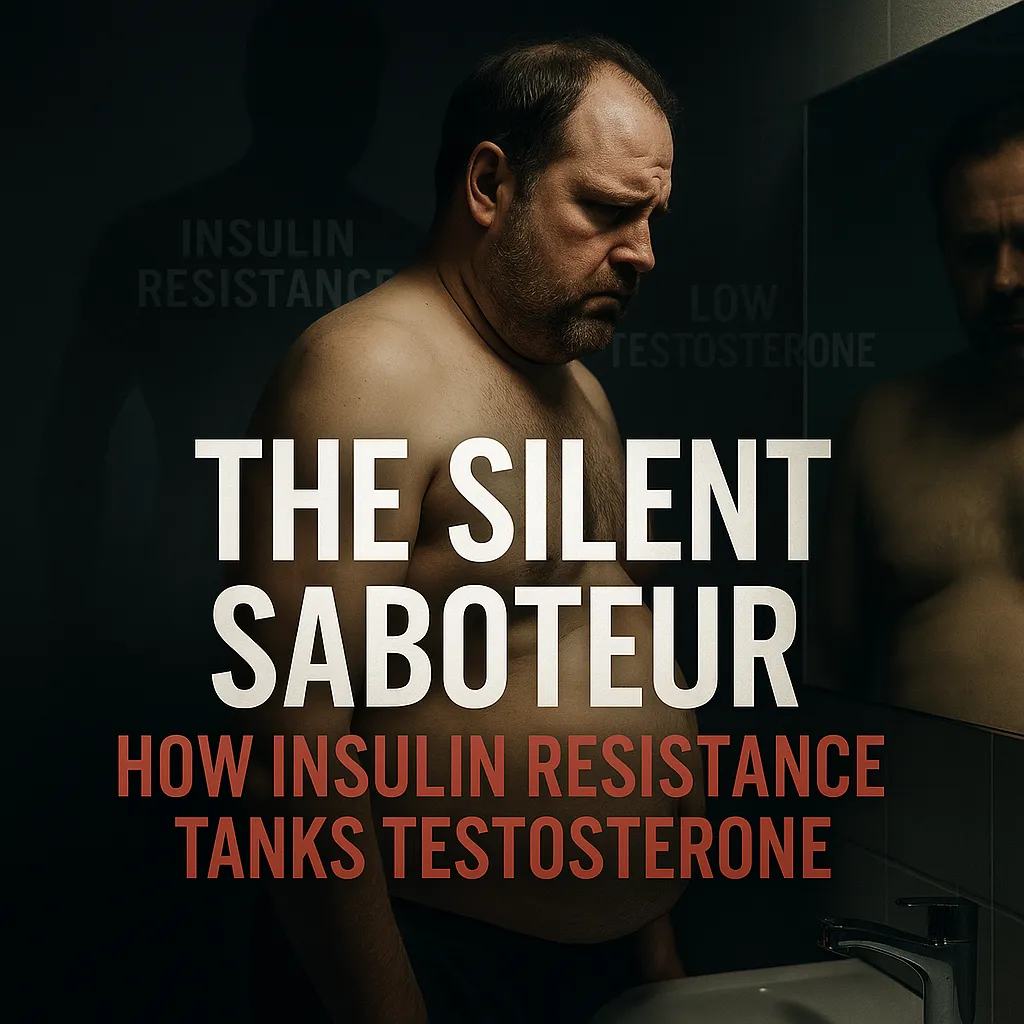
The Silent Saboteur: How Insulin Resistance Is Destroying Men’s Testosterone, Energy, and Performance After 40
By Dr. Andreas Boettcher, D.C., Functional Medicine, B.S. Health/Exercise Science
3x Ironman Triathlete, Master's Men's Physique Competitor
The Silent Saboteur: How Insulin Resistance Tanks Testosterone
…and Destroys Performance from the Fitness Room to the Boardroom to the Bedroom
If you’re a man who feels more tired than you should, softer around the waist, less driven, and not quite yourself in the bedroom, the first thing most clinicians tell you is:
“Your testosterone is low. You need TRT.”
But after more than 30 years of working with thousands of men in private practice, I can tell you with certainty:
Low testosterone is often not the root problem.
Insulin resistance is.
And insulin resistance is not only common—it's epidemic. It is one of the most misunderstood, under diagnosed, and most preventable metabolic disruptions men face today.
Even more concerning is how many men are being placed on medications and TRT without anyone ever evaluating their metabolic health, which is mind-blowing to me and one of the most consistent oversights I see in modern medicine.
Let’s break down exactly what’s going on.
How Common Is Insulin Resistance?
Globally, research suggests roughly one in four adults meets criteria for insulin resistance.
But I believe that number is much higher, because insulin resistance is profoundly under diagnosed and often ignored until it has already progressed for years.
In the United States, data show that nearly 40% of young adults—men in their 20s, 30s, and early 40s—are already showing signs of insulin resistance and cardio-metabolic dysfunction.
And according to the CDC, 38% of U.S. adults have pre-diabetes—and most don’t even know it.
And here’s what still shocks me—even after 30+ years in practice:
I’ve been on countless consultation calls with men whose physician told them, “We’ll just keep an eye on it until it becomes full-blown diabetes,” essentially allowing the metabolic train wreck to continue until the wheels fall off.
This isn’t just negligent. It’s dangerous.
Insulin resistance doesn’t suddenly appear when someone becomes diabetic.
It builds silently, damaging your metabolism, hormones, brain function, cardiovascular system, and energy production for YEARS.
And because it is missed so often—and because most doctors wait until it reaches crisis levels—the true prevalence is likely far beyond the “1 in 4” headline statistic.
Layer on the well-established connection between insulin resistance, visceral fat, and suppressed testosterone production, and the picture becomes clear:
Millions of men are being treated for “low T” when the real issue is metabolic dysfunction that has never been addressed.
What Is Insulin Resistance? (Plain English)
Insulin is the hormone that acts like a key, unlocking your cells so glucose can enter and be used as fuel.
Insulin resistance means your cells have stopped responding to insulin correctly.
So your body pumps out MORE insulin to force the fuel inside.
More insulin leads to:
more fat storage
more inflammation
more hormonal disruption
more metabolic stress
This brewing metabolic storm develops slowly—often over a decade or more—until eventually you’re dealing with:
low testosterone
stubborn fat
low libido
irritability
poor recovery
brain fog
low energy
high blood pressure
abnormal lipids
Insulin resistance is not “just a blood sugar problem.”
It is one of the central drivers of male hormonal decline.
How Insulin Resistance Tanks Testosterone (The Real Mechanism)
Most men don’t realize how tightly testosterone production is connected to metabolic health.
Here’s exactly how insulin resistance crushes testosterone and male performance.
1. It Shuts Down Testosterone Production at the Testes
Your Leydig cells—the testosterone-producing cells in your testes—depend on healthy insulin signaling and mitochondrial energy.
When you’re insulin resistant:
Leydig cells cannot use insulin properly
they struggle to use glucose for fuel
mitochondrial ATP output drops
and testosterone production plummets
Producing testosterone is an energy-intensive process.
If the “power plant” fails, testosterone output drops sharply.
2. It Converts Testosterone Into Estrogen
Insulin resistance leads to increased visceral fat (especially around the abdomen).
This type of fat contains aromatase, the enzyme that converts testosterone to estrogen.
So now:
you make less testosterone
you convert more of what you DO make into estrogen
estrogen increases fat gain
and fat gain increases aromatase further
A dangerous hormonal loop begins.
3. It Raises Inflammation — Which Blocks Testosterone Receptors
Inflammation is one of the direct byproducts of insulin resistance.
And inflammation interferes with androgen receptors—the “docking stations” where testosterone binds and delivers its signal.
Think of testosterone as a key
and the androgen receptor as a lock.
Inflammation fills the lock with glue.
You may have testosterone in your blood—even be on TRT—but if your receptors are blocked, the hormone cannot exert its effects.
This is why so many men on TRT STILL feel terrible.
4. It Damages Mitochondria (Your Cellular Engines)
Mitochondria are the power plants of your cells.
They drive:
energy
metabolism
focus
strength
testosterone production
Insulin resistance starves them of balanced fuel and forces them into stress mode, decreasing ATP output and increasing oxidative damage.
Low mitochondrial output =
low testosterone + low energy + low motivation.
5. It Binds Up Your Testosterone (SHBG Goes Up)
In insulin resistance, SHBG (sex hormone–binding globulin) often rises.
SHBG attaches to testosterone and prevents it from being used.
So even if your total testosterone is “normal,” your free testosterone— the usable form — may be very low.
This is why many men with “normal” labs feel half alive.
6. It Disrupts Thyroid Function
Thyroid hormones drive metabolic rate and support testosterone synthesis.
Insulin resistance blunts thyroid activity.
Low thyroid → low testosterone → low metabolism.
How This Shows Up in Your Life (Fitness, Boardroom, Bedroom)
Insulin resistance doesn’t just harm hormones.
It harms the entire ecosystem of male performance.
In the Gym
belly fat accumulates
strength gains stall
recovery slows
workouts feel harder
endurance drops
muscle becomes stubborn
In the Boardroom
mental sharpness declines
motivation drops
decision fatigue increases
irritability rises
stress tolerance collapses
confidence dips
In the Bedroom
libido drops
erections weaken
sensitivity decreases
drive and enthusiasm fade
This isn’t “getting older.”
It’s metabolic deterioration.
What Causes Insulin Resistance in Men?
Multiple factors create insulin resistance, including:
excessive sugar and processed carbs
frequent snacking
overeating
late-night meals
alcohol
industrial seed oils
sleep deprivation
chronic stress
environmental toxins
sedentary lifestyle
low muscle mass
visceral fat
micronutrient deficiencies
gut inflammation
certain medications
low testosterone, which worsens insulin sensitivity
It’s almost always a cluster, not one single cause.
And the good news is:
Clusters can be reversed.
Diagnosis: The Functional Medicine Approach
This is where most traditional medical evaluations fall short.
Conventional medicine often waits until fasting glucose or HbA1c crosses into a disease category before taking action—at which point significant metabolic damage has already occurred.
Functional medicine looks earlier, deeper, and more accurately.
Here are the optimal functional ranges we use:
Fasting Blood Glucose
Optimal: 85 mg/dL
Why: This is where insulin sensitivity is strongest and metabolic risk is lowest.
HbA1c
Optimal: 5.2% or below
Why: Damage begins way before the 5.7% “pre-diabetes” cutoff.
Fasting Insulin
Optimal: Under 5 μIU/mL
Why: Insulin rises YEARS before glucose or HbA1c change. It’s the earliest warning sign.
Triglyceride-to-HDL Ratio
Optimal: 1.5 or less
Why: One of the strongest predictors of insulin resistance and cardiovascular risk.
HOMA-IR
Optimal: Under 1.0
Why: Reveals insulin resistance even in men with “normal” glucose.
This integrated approach is how we catch metabolic dysfunction early—before testosterone collapses, before visceral fat accumulates, and before your performance falls apart.
How to Reverse Insulin Resistance
Insulin resistance is not a life sentence.
It is absolutely reversible with the right plan.
1. Eat to Improve Insulin Sensitivity
high-quality proteins
healthy fats
low-glycemic carbs
eliminate seed oils
reduce sugar and alcohol
2. Build Muscle
Muscle is the #1 insulin sink.
Build muscle → improve insulin sensitivity → raise testosterone.
3. Train Mitochondria
Strength training, Zone 2 cardio, and strategic intervals rebuild metabolic power.
4. Prioritize Sleep
Sleep restores hormones and insulin sensitivity.
5. Lower Stress
Chronic cortisol spikes worsen insulin resistance and belly fat.
6. Lose Visceral Fat
Even modest reductions dramatically improve hormones.
7. Get the Right Labs
You must measure the system to fix the system.
The Bottom Line
If you’re dealing with stubborn fat, low libido, low energy, declining strength, poor sleep, brain fog, or you’re being pushed toward TRT or medications…
You must ask:
“Has anyone actually evaluated my insulin resistance using functional markers?”
Because if insulin resistance is the true driver—and it often is—
TRT alone will never fix your symptoms.
You are not broken.
Your system is out of alignment.
And alignment can be restored with the right strategy.
⚡️ Ready To Take Charge of Your Health With the Most Comprehensive Natural Approach to Mens Health?
If you’d like to go deeper — to uncover the root causes behind your energy, hormones, metabolism, and performance — I invite you to book a complimentary consultation.
Together, we’ll review your health history and goals and determine if our Peak Performance Protocol based on your lab analysis, genetics, and lifestyle data is right for you!
👉Click here to schedule your complimentary consultation.
To learn more about our approach and success stories, visit www.ItsOnlyHalftime.com where we help men like you turn your second half into your best half naturally!
Finish Strong,
Dr. Andreas
Still Kickin' A** Medication Free at 55 Despite What the "Narrative" Would Like You To Believe!

Medical Disclaimer:
The information provided in this article is for educational and informational purposes only and is not intended as medical advice. It should not replace professional consultation, diagnosis, or treatment. Always consult your healthcare provider before making any changes to your health regimen or lifestyle.
References
Ballena-Caicedo J., et al.Global Prevalence of Insulin Resistance in Adults: A Systematic Review and Meta-analysis.PLOS/PMC, 2025.
https://pmc.ncbi.nlm.nih.gov/articles/PMC12411212/Ottarsdottir K., et al.The Association Between Serum Testosterone and Insulin Resistance in Men.Journal of Clinical Endocrinology, 2018.
https://pmc.ncbi.nlm.nih.gov/articles/PMC6311464/Li M., et al.Trends in Insulin Resistance: Insights Into Mechanisms and Prevalence.Signal Transduction and Targeted Therapy, 2022.
https://www.nature.com/articles/s41392-022-01073-0Fahed M., et al.Evaluation of Risk Factors for Insulin Resistance: A Cross-Sectional Study.BMC Endocrine Disorders, 2020.
https://bmcendocrdisord.biomedcentral.com/articles/10.1186/s12902-020-00558-9Pitteloud N., et al.Relationship Between Testosterone Levels, Insulin Sensitivity, and Mitochondrial Function in Men.Diabetes Care, 2005.
https://pubmed.ncbi.nlm.nih.gov/15983313/Hayes F.J., et al.Testosterone and Insulin Resistance in Men: Mechanistic Links.National Institute of Health Clinical Data, 2025.
https://www.ncbi.nlm.nih.gov/articles/PMC12323448/Bermudez V., et al.Prevalence and Associated Factors of Insulin Resistance in a General Adult Population.Journal of Metabolic Health, 2016.
https://pmc.ncbi.nlm.nih.gov/articles/PMC4989131/Medscape.Insulin Resistance: Background, Pathophysiology, and Etiology.Medscape Clinical Review, 2025.
https://emedicine.medscape.com/article/122501-overviewLutz S.Z., et al.Sex-Specific Associations of Testosterone With Metabolic Risk: Insulin Resistance as the Link.Frontiers in Endocrinology, 2019.
https://www.frontiersin.org/articles/10.3389/fendo.2019.00090/full


